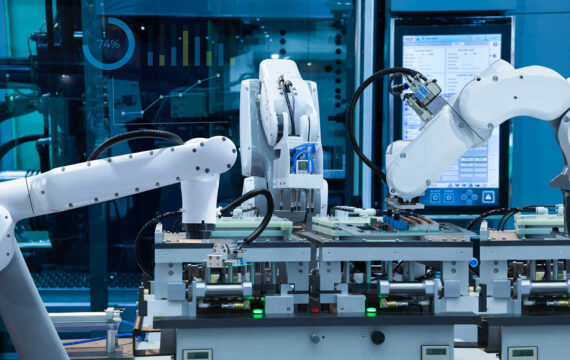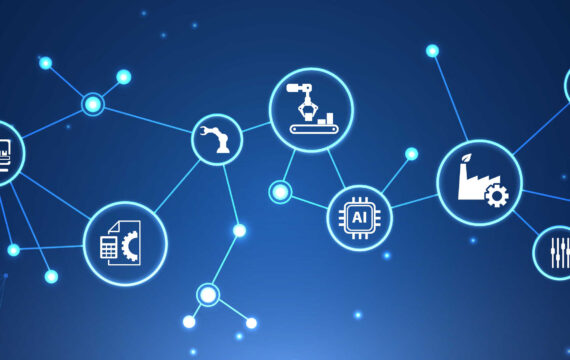Anyone who’s ever built a house or had an apartment renovated knows that it never turns out the way you initially planned. The work usually takes longer, costs more, and is of a lower quality than what you originally envisioned. And this seems to be a global problem: massive construction projects encounter the same time and cost issues that you run into when building a house. Luckily, we can rely on IoT in construction industry.
McKinsey states that large construction projects typically last 20% longer than scheduled and cost 80% more than expected. With numbers like these, it’s critical to fix construction issues sooner rather than later. While several years ago the cost of implementing IoT in construction industry was still too high to consider it seriously, things have drastically changed. A multitude of sensors can fit dozens of use cases, connectivity has become cheaper, and the Platform as a Service business model is no longer rare. Construction businesses have all the conditions to start adopting IoT into their processes, improving productivity, and better meeting customer expectations.
Here’s how the Internet of Things can help to revitalize the construction space.
Implementing IoT in construction industry
Virtually any device that can be equipped with sensors and transmit data to the internet can become part of an IoT construction network. In IoT construction, these devices include machinery, vehicles, consumables, and wearables. The Internet of Things construction industry technologies help you collect data about a variety of processes and pieces of equipment involved in a project as well as connect an entire construction site (or even multiple sites) via the internet for a consistent view of project progress. And that’s not all. Here are some of the IoT devices the construction industry uses to manage, track, control, and analyze data.
- Supply sensors
A smooth supply of materials is critical for meeting deadlines and targets in construction, and this supply is often affected by poor management and erroneous scheduling. By equipping a supply unit with sensors, it’s possible to automatically track the quantity of materials, set alarms, and place automatic orders.
- IoT-enabled tags
Materials can be tagged not only for tracking but to prevent theft and misdirection of resources. With huge construction sites, it’s now easy to locate and monitor any item without sending employees to investigate every case. Connected tags can also be used for machinery and trucks.
- Fuel sensors
The cost of a project largely depends on fuel and power consumption, since large construction sites use machinery that burns thousands of dollars a day. Control over expenditures, efficient management of refueling, timely maintenance, and upgrading machinery that uses too much power or fuel can make a significant difference in the final cost and duration of a project. Fuel sensors can do just that on a construction site.
- Heat/humidity sensors
Some equipment, materials, and construction elements have specific storage requirements. In certain circumstances, proper storage will prolong the operational life of equipment. But there are also cases when keeping materials and construction elements in proper condition is project- and even life-critical. IoT in construction can be used to monitor temperature, humidity, pressure, and other metrics for warehouses, environments, and individual items and alert about any changes that can cause damage.
- Real-time site maps
With the help of IoT construction sensors and beacons, construction sites can be turned into real-time digital maps showing danger zones, work in progress, hazardous environments, employees on-site, etc. Various types of devices can monitor the air quality in closed spaces or alert about dangerous rises in temperature or pressure, land shifts, danger of falling objects, etc. In this way, construction sites can become more predictable, better controlled, and safer. Meeting safety issues is critical since the construction industry is known to be one of the most dangerous: the construction, transportation, and moving industries accounted for 47 percent of all worker deaths in the US in 2017.
- Wearables
We’re already used to wearing various smart devices, and the construction industry leverages them as well. Some wearables can monitor a worker’s body, tracking pulse, breathing, stress levels, etc. Wearables can also help to control labor hours of all subcontractors and the time workers spend operating machinery. (Handling equipment for too long may cause loss of concentration and decrease safety on the site.) With the IoT in construction industry, it’s even getting more common to adopt advanced wearables such as smart glasses. Enhanced with virtual reality (VR), augmented reality (AR), or mixed reality (MR), heads-up displays are used for planning modeling and on-site work, such as checking instructions and synchronizing changes. With multiple contractors and employees, glasses connected to the cloud can seriously improve performance and productivity.
- Equipment trackers
Predictive maintenance and timely repairs are the primary aim of equipment trackers. Transmitting information on the status of machinery, service alerts, and automatic operating time logs can significantly reduce the cost of failures and pauses in work.
- Concrete curing sensors
To speed up construction schedules, concrete curing sensors can be used. IoT devices monitor concrete maturity through temperature probes and pass information to the cloud in real time. Sensors are embedded in concrete during casting and track its curing, allowing managers to precisely plan further work.
- Sensors for structural health monitoring (SHM)
The construction of critical infrastructure requires reliable data and timely analysis. Structural health monitoring (SHM) is aimed at assessing civil and structural engineering constructions by gathering information about vibration, strain, temperature, material degradation, and other physical conditions and states that affect the integrity of a structure. Various types of sensors help to detect damage and its severity, calculate endurance, fulfill predictive maintenance, and prevent incidents. These sensors can be installed on bridges, dams, underwater elements, etc. and provide the possibility of non-invasive monitoring.
Although the construction industry is quite suspicious of new tech and therefore lags in terms of innovation, IoT is slowly but steadily making its way through the various fields of construction. Let’s examine real-life use cases of IoT and the benefits that connected sensors, tags, and wearables bring to different aspects of the construction process.

IoT in construction industry: Popular use cases

The major areas where IoT development is deployed in the construction industry are remote operations, equipment maintenance, fleet management, fuel monitoring, and building information modeling (BIM) according to a report by Kenneth Research.
Remote operations
Measurement devices like sensors and cameras can help to remotely control and adjust machinery, increase the precision of operations, track and report the movement and progress of workers in real time and, therefore, better coordinate building activities. Trimble is an IoT construction company that brings innovation to the field by powering machine control for earthworks, paving, drilling, and piling.
Wearables
GPS trackers, heart rate monitors, and pressure and air sensors are not the only IoT devices one can meet at a construction site. Smart working boots from SolePower track location, status, and environmental factors with GPS, radio-frequency identification (RFID), and inertial measurement units (IMUs), send data to the cloud, and project statistics on a dashboard for management and analysis. Spot-r Clip is another wearable device that not only tracks worker attendance and location but improves safety by reporting falls, signaling distress, and triggering an emergency alarm to speed up evacuation in case of a general hazard.
Smart glasses like DAQRI and Microsoft HoloLens are a higher level of wearables, combining IoT and augmented reality. They not only reinforce human vision with environmental-based insights and real-time instructions but create a whole bunch of new use cases in construction, from 3D modeling to employee training.
Tracking
Connecting all machinery, equipment, materials, and shipments into one easily manageable network is not a fantasy anymore. With the help of radio-frequency identification (RFID) tags and sensors, it’s possible to control processes on the construction site as well as the supply chain. Track, for instance, is an example of a solution for connecting and monitoring the operation of construction machinery.
Building information modeling
During construction, IoT devices can report any changes in materials and the environmental conditions; track separate parts, details and items; and update BIM models in real time. Likewise, when detecting an issue with the help of a sensor or tag, a BIM model, linked to IoT devices, can provide analysis of and diagnose a problem. Say that sensors in one space report an increase in temperature. Using the BIM model, one can remotely check the connection of this space to the ventilation or any other factors that may be the reason for the problem. VisuaLynk offers an early example of connecting IoT to a BIM model.
Summing up: Power efficient Internet of Things construction industry
The construction industry is slow at adopting innovations, but IoT devices are steadily winning recognition in various parts of building sites as well as construction offices. Businesses acknowledge the potential of IoT to improve cost-efficiency, scheduling, and quality of work. Multiple sensors, tags, real-time tracking, and wearables of all kinds are no longer oddities on construction sites, and this trend will only continue to ramp up. Now that the adoption of IoT has begun, the sky is the limit. Digital twins, autonomous machinery, smart buildings — it all starts with the small steps IoT is currently making in construction.
Speak with Intellias experts about how to introduce IoT connectivity into the construction field to optimize cost efficiency and unleash the full technological potential of smart buildings.




